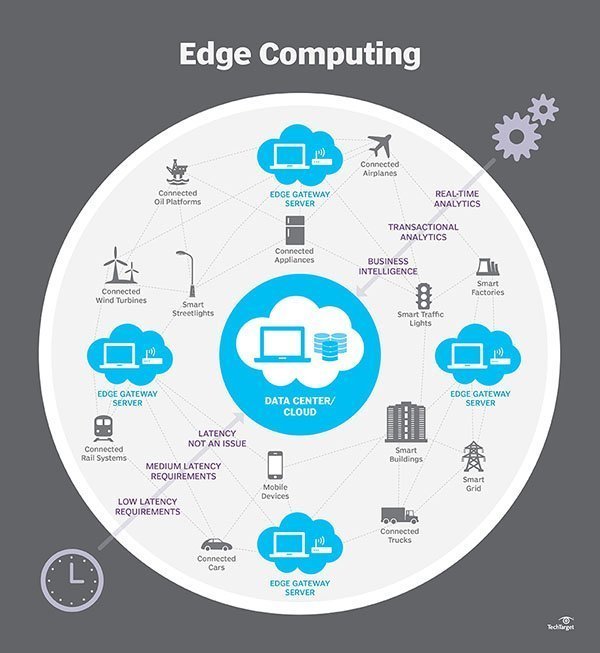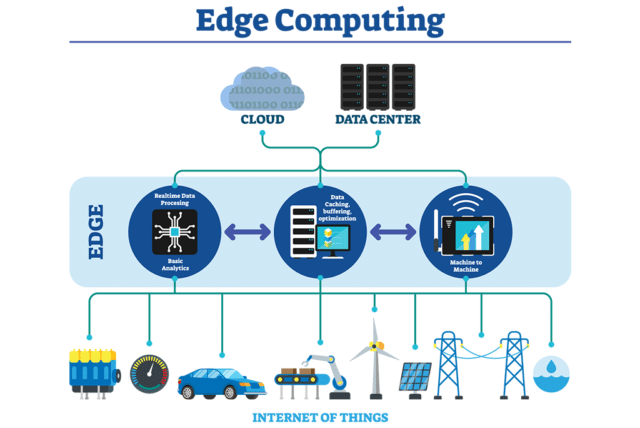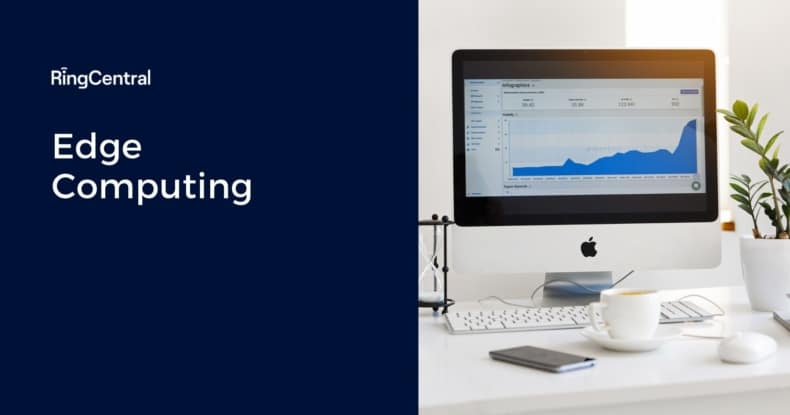In this article, we'll cover:
One of the most important aspects of any business is data. It informs everyday decisions, helps you plan for the future and keeps you ahead of the competition. Unfortunately, the ‘old’ ecosystem using the cloud and centralised data centres doesn’t work as well with the growth in the amount of data.
One term you may have heard a lot recently is ‘edge computing’. Just what is edge computing, how does it work and what problems can it solve?
What is edge computing?
Edge computing is a form of IT (information technology) architecture where the client data is processed closer to the data source. Many people confuse edge computing with IoT (internet of things) but they’re not quite the same thing – IoT is a use case of edge computing, but not all edge computing is the IoT
Edge computing has its origins in the content delivery networks of the late 90s. These were created to help serve web (and video) content from servers that were closer to end users. These then evolved in the early noughties to also host apps and app components, thus becoming the first examples of edge computing services. Amazon and AWS are already at the forefront of the on-demand edge sector.
How does edge computing work?

The primary factor is location. In normal enterprise computing, you are producing and processing data at your computer. It’s then moved across a wide area network (WAN), for example, the internet, either to a corporate local area network (LAN) or the cloud – and those servers can be based anywhere in the world.
Edge computing power changes the focus from those centralised data centres in distant locations, to the edges of the existing computing infrastructure. This places both data storage and computing services closer to the point where the actual data is generated, increasing response times.
With Gartner predicting over 15 billion IoT devices connecting with enterprise infrastructure by 2029, edge computing looks set to play a vital role.
Common types of edge computing

A. Telco edge computing
For telco (telecommunications) companies, edge computing refers to a distribution of data which goes beyond the edge of the network itself and extends into the customer’s network. It allows customers to run and use low latency applications and edge devices, as well as process or cache data closer to source in order to reduce costs, traffic, and congestion.
B. Network edge computing
Network edge computing refers to when networks owned by enterprises (for example, wireless LAN or data centres) connect to the various third party networks. Many IoT solutions are based here due to the low latency it provides. Additionally, many cybersecurity options are based here due to it being a common ‘threat barrier’ – the point between the global internet and your local data.
C. On-premise edge computing
This is when resources are on a customer’s actual premises and managed by a network operator in respect to apps and functionality. Functions run in virtual environments and are cloud-based across the distributed edge infrastructure. By keeping this on premises, it offers better security for sensitive info.
Problem areas edge computing addresses
But why invest in edge computing, rather than local or cloud computing? There are a few key problem areas it can address:
- Latency: If you are connected to the net, you want swift responses. If there is any lag, it is known as latency. Edge computing can eliminate latency as it is a more distributed network, offering real-time data, responses and better
- Bandwidth: With edge architecture, you can greatly reduce any network and bandwidth issues associated with moving (and using) a lot of data. Edge computing can process data at, or near, the source. This can also reduce reliance on costs such as data plans and sim cards.
- Network congestion: If you build more roads, congestion lessens. This is what edge computing achieves by easing pressure on wider area networks. Instead of flooding the network with raw data, local devices analyse, filter, and compress any data locally.
- Security & privacy: with edge computing architecture, any outages are limited to the particular device and its local applications.
Edge vs. fog vs. cloud

While closely related, these are three different types of computing. They all relate to distributed computing and have a clear focus on the actual physical location and deployment of computing and storage resources.
1. Edge
As previously highlighted, edge computing refers to deploying your resources at the source of data production. This usually means having computing and storage in the same location as the data on the network edge.
2. Cloud
Cloud computing refers to massive and scalable deployment of computing and storage resources at various locations. Providers of public cloud services usually also offer a variety of other services for IoT devices, making it a preferred centralised platform. Your closest cloud facility could still be a long way away, meaning you can still encounter the same issues of connectivity.
3. Fog
Cloud computing may be too far from you but you may not have the resources to make the full switch to edge computing. Fog computing (or edge cloud, if you will) is a sort of “in-between” option. A fog computing environment can process massive amounts of data in a decentralised location closer to you, rather than in a centralised data centre elsewhere.
Practical edge computing use cases

Manufacturing
Edge computing can help you analyse data from different machinery, systems and processes so that you can adapt and tweak the overall manufacturing process. Doing this utilises massive amounts of data and also requires machine learning (ML). Processing this in the cloud won’t give you the instant results you might need, whereas edge computing can.
Healthcare
One key area edge computing can help is with patient sensors. By integrating the edge, you get better all-round visibility of patients, with near-instant feedback. Delays can hugely impact an individual’s healthcare, reducing latency is vital. You can also process data locally to improve patient privacy.
Retail
In food retailing, temperature control is essential for storage of perishable food. Edge computing can collect and analyse data from refrigeration systems and building systems so that correct temperatures are maintained.
Gaming experiences
Modern gaming is as complex as other areas of computing. In particular, cloud gaming streams live feeds to devices and is very much dependent on latency, especially in multiplayer games. By building edge servers closer to their customers, service providers can reduce latency issues.
Agriculture
There is increasing use of autonomous vehicles (agribots) in agriculture. Edge computing can help localise the various sensors that direct these agribots, thus increasing operational efficiency.
Transportation
While widespread automation may not be here yet, the use of edge computing solutions in areas such as autonomous truck convoys will play a big part in cost-effectiveness and efficiency. It also relates directly back to retail, as temperature-sensitive goods need to be monitored during transportation.
Network optimisation
As we move to higher amounts of people subscribing to 5G networks, edge computing can help with network optimisation to meet the increasing amount of traffic as well as helping to reduce costs and expenditure.
Military
Like any other sector, the military now incorporates huge levels of tecnh. One example is in fighter jets such as the F-35. Edge computing allows multiple planes to use MADL (multifunction advanced data link) so that a formation of planes almost becomes a single entity, sharing data and info.
Benefits of edge computing
As well as resolving particular problems, edge computing has a large range of benefits, including:
1. Device and data performance improvement. Your data is being processed closer to the source and traffic is prioritised, leading to lower latency and better performance.
2. Edge security. Edge is less vulnerable to DDoS attacks because it is more widely distributed. It may be more vulnerable to some attacks such as malware, but its distributed nature makes it easier to implement security measures to prevent such attacks.
3. Cost-efficiency. Edge allows you to categorise and prioritise data which means better cost management. As different resources need to be allocated for different types of datas, you can be more cost-efficient by only allocating needed resources.
4. Lower latency. This is one of the biggest benefits. Because your data is distributed locally or in nearby edge centres, wide distribution means your network performs better.
5. Can execute specific performance results. Your edge network essentially works as a series of small interconnected networks, allowing you to use different hardware, software, and even programming languages to achieve specific results.
6. Autonomy. Moving away from a centralised network offers your enterprise more autonomy in how you set up and manage your data networks. Autonomous management software can help with tasks such as execution, deployment, and validation of workloads.
7. Data sovereignty. Because you are processing your data closer to its source, edge computing allows you more sovereignty over your data, something that may be essential for sensitive info or for regulatory reasons.
Challenges in edge computing
However, as with any technology, edge computing does come with challenges.
- Data lifecycle management. You will likely have lots of data, much of it unnecessary. Managing your data’s lifecycle when so much of it is close to the source is crucial, especially when it comes to the data you need to retain for regulatory purposes.
- Limited connectivity and control. Edge architecture can in some cases affect connectivity and control. Most current edge solutions focus on specific uses. Overcoming this requires integrating computing, connectivity, and storage.
- Network segmentation. More data means more apps are constantly working. Many of them are very sensitive to latency. Edge means more distribution and segmentation, so managing this efficiently can be a major challenge.
- Edge computing management. EC has management challenges you do not find in other solutions. By sending essential apps and data to the edge, it is crucial that the edge architecture functions efficiently and offers reliability no matter how much you add.
- Difficulty to track devices and assets. With EC, it can be tricky to track and monitor what devices and assets are connected to the network. That means you need better IT security protocols and tools to manage what devices can access the network.
Edge computing & 5G

5G and Edge are the new kids on the block and are inextricably linked. Working together, you will see a significant improvement in how your apps work and how quickly data can be processed in real time. Depending on your network, 5G can be as much as 10 times faster than 4G (and this is likely to improve as networks adapt).
With edge computing reducing latency and offering better device and data performance, the combination of the two (when both are up to full speed) is going to offer vastly improved performance and connectivity compared to traditional networks.
Is your business edge computing-ready?
Adapting to edge computing will, at some point, be a necessity rather than a choice. With the growth of artificial intelligence and concepts like smart cities on the horizon, 76% of business leaders say that finding the right location for data processions is an absolute must.
When it comes to digital transformation, you have to consider what you want to achieve: better customer experience? Better distribution channels? Scalability? Making a decision on the switch means you need to balance your current needs with your current resources.
As 5G is not yet up to speed, you may want to hold off until you can get the full benefits that will be available. But your CIO can start planning now, looking at what the transition entails and what it will cost.
Originally published Oct 19, 2021

